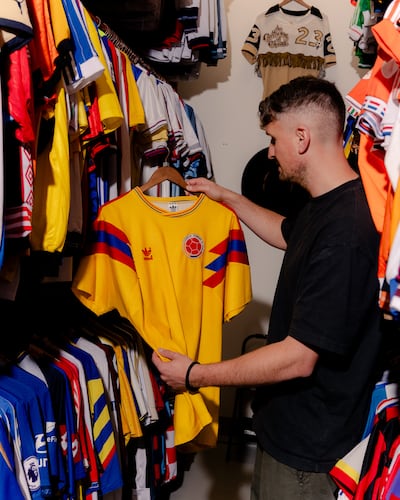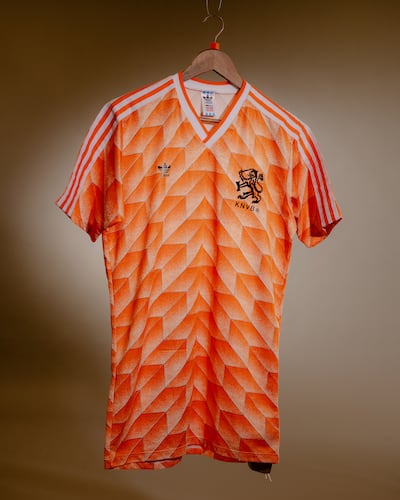The temperature drops perceptibly as Doug Bierton discreetly sweeps the bracelet on his left wrist over a wall-mounted sensor and enters the vault.
Like access to this locked room the climate inside it is strictly controlled. To the uninitiated this might seem excessive. Its contents are not jewels or watches or the treasures of some lost civilisation. They are instead soccer jerseys: roughly 6,500 of them, hanging from great metal racks.
This is just a tiny fraction of the stock that Bierton’s company, Classic Football Shirts, holds at any given time. In the cavernous warehouse that surrounds the vault there are at any given moment more than 1 million jerseys, hats and other pieces of apparel. This room is for those items Bierton cannot bear to part with, the pieces – including match-worn editions of some of the most iconic jerseys in history – he has deemed too precious to sell.
At first glance it does not seem like that. The overall impression is of an overstuffed closet: a jumble of man-made fabrics and a riot of colour, all vivid reds, lurid yellows and royal blues.
Bierton, though, can find any particular jersey in just a few seconds. He has memorised the provenance, the background and the story of each one. He knows the stains, and the defects, that prove their authenticity.
He has been in the business of buying and selling soccer jerseys for almost 20 years, since he founded Classic Football Shirts, an online platform for trading vintage editions, with a friend in 2006. At heart, though, he remains an enthusiast, a collector and a fan.

Bierton winces a little when asked to choose his favourites among the company’s private reserve – “I think I’d rather pick between my kids,” he said – but it is telling that the ones he gravitates toward are not necessarily the most valuable, the rarest or the most daring in design, but the ones that mean the most to him.
His prize possession, for example, is a jersey from the 1991 final of the Cup Winners’ Cup, a now discontinued European competition. That match was won by Manchester United, the team Bierton supports. It is one of the first games he remembers.
He also has a particular fondness for the uniforms of the Italian team Fiorentina, and particularly the 1999 edition. The shirt, a deep, rich purple, is almost indistinguishable from the deep, rich purple versions of the years before and after, but it is the one that he remembers the club wearing when it came to Manchester to play United.
Bierton sees the vault as many things. It is a store of future value for his business. It is an archive of soccer history, a resource that can be used for museums, exhibitions or television documentaries. It is a monument to a collector’s obsession. Most of all, though, the polyester treasures it contains are a way of telling a story. Each jersey acts as a repository of memory.
At the end of a recent vacation in London, Ilka Husmann and her daughter Eila found themselves in one of the world’s greatest cities with a day to spare. They wanted to crown the trip with a “highlight”, Husmann said, before returning home to Germany. Eila knew exactly what that should be even if it meant a two-hour train ride to Manchester.

“We had already been to the Classic Football Shirts store in London,” Husmann said. “But she wanted to come to the one in Manchester, too.” In her hand, she held the fruits of their trip: half a dozen vintage items, including Manchester United, Manchester City and Liverpool jerseys from the early 1990s.
In the tribal world of English soccer the haul bordered on heresy: So deep are the rivalries between those clubs that it would be taboo for one person to wear the jersey of more than one of them. That does not concern Elia. “I wear them as streetwear,” she said. The design, and the era they conjure, are more important to her than the affiliation.
Classic Football Shirts has noticed more and more customers like her in its stores in recent years as vintage soccer jerseys first bled into streetwear and then earned the influencer stamp of approval.
The trend may have reached its peak last year when Kim Kardashian decided to go for a walk in a 1997 Roma jersey, and her ex-husband, Ye, appeared in a wholly forgettable Portsmouth goalkeeper shirt. Drake, Addison Rae and Robert Downey Jr., among others, have endorsed teams from Juventus to Celtic.
Classic Football Shirts does not quite know why this has happened, but it is not complaining. When Bierton and a friend, Matt Dale, founded the company in 2006, it was part passion project and part side hustle for two students attracted to older and more offbeat jerseys than the new ones being sold by clubs every year.

In the early days they would spend hours online chasing unwanted jerseys; scouring second-hand stores and market stalls; and arriving unannounced at retailers and happily heaving their unwanted stock into a van.
Now, in addition to two permanent stores, they have run pop-ups in Berlin, Tokyo and New York. They acquire stock directly from the companies that manufacture jerseys. And they sort the hundreds more vintage editions that still arrive at their warehouse every day, unearthed from the backs of closets and private collections. The company authenticates them, passes them under the expert eyes of its valuation “gurus” and then sells them on.
That may just be the start. Last year a private equity firm, The Chernin Group, bought a stake in Classic Football Shirts. In September former US striker Alex Morgan, soccer commentator Stu Holden and actor (and Wrexham co-owner) Rob McElhenny also invested. The company’s plans include opening stores across the United States.
Part of the appeal, without a doubt, is the streetwear boom. Greg Bettinelli, a partner at The Chernin Group, sees in vintage soccer jerseys a market similar to that catered to by the sneaker exchange sites StockX and GOAT. “It’s become cool to wear classics,” he said. “Not jerseys that you’re buying on Arsenal.com. Ones that are hard to find and impossible to replicate.”
That, to Bierton and Dale, is the key to everything their business has become. Vintage jerseys do more than declare loyalty to a team. They root the wearer in a specific era, act as a gauge of the depth of their fandom. “They’re kudos-related,” Bierton said. “They’re a way of saying: ‘I get it.’
”Soccer came relatively late to the idea that fans might want to wear the jerseys of their favourite teams. There are some really famous ones that never really existed as replicas,” Bierton said. “If you look at some of the shirts from the 1990 World Cup, say, there were only ever a handful of them: one for each of the players in the team, and maybe a few spares.”

Over the past three decades the sport has done all it can to make up for lost time. Since the early 1990s it has become standard for teams to release at least one new jersey every year, and often as many as three: home and away editions and frequently an alternate design to be worn only on special occasions or in cases of extreme colour clash with an opponent.
Sometimes the changes are merely cosmetic: a modified trim, or a different type of collar. Occasionally they are more stark: a new sponsor, a new manufacturer, an entirely new colour.
The rationale, of course, is pure uncut capitalism. But the effect is profound. The precise combination of design, sponsor and manufacturer happens only once, representing not just a team but a moment in time.
“They take you back to a specific place in your life,” Dale said. “It might be where you were, or what you were doing, when you first saw them. Or it might be a particular game, or a particular goal. They kind of tie together the tapestry of your past.”
One of Dale’s great pleasures is witnessing that happen in real time in one of the stores. “People have an almost physical reaction to seeing some of the shirts,” he said. Much of the time that response is reserved for one of the established classics, what Bierton refers to as the “OG” jerseys: iconic designs like the Netherlands in 1988, West Germany in 1990.

“Some of that is rarity – they didn’t produce as many replicas then, so there aren’t as many – and some of it is the design,” he said. “But it’s also what they meant.” In the stores the most expensive jerseys, priced at around $500, largely come from that group.
But there is a generational difference too. What makes a jersey a classic is personal meaning as much as design, just as what makes something vintage depends on your age.
That is the bet that the company’s new investors have made: that vintage soccer jerseys are more than just a streetwear fad, and that each successive generation will fall in love with a new set of favourites. It is also what has led two former college students with an interest in old jerseys to a world in which they are running pop-up stores a Continent away, collaborating with Adidas, and having Zoom calls with McElhenny.
“It’s incredible, really,” Bierton said, standing in the cool air of the vault, surrounded by the jerseys he cannot bear to sell. “It’s just a shame that it all means I get less time with the shirts.”
This article originally appeared in the New York Times.
2024 The New York Times Company



















